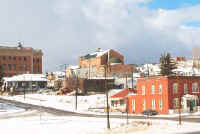| |
Dublin Gulch
|
|
|
"They've got cars Big as bars
They've got rivers of gold
But the wind goes right through you It's no
place for the old"
Shane
McGowan |

|
| So
in late August 1915, the boarding house at 67, East Copper Street, Butte
was home to Henry J. and several of his friends from Kilkeel and the
surrounding villages. East Copper Street was in an area of Butte known as
“Dublin Gulch". This was a pitifully poor area of town that was home to
many Irish immigrants who worked the mines. Living conditions in the area
were extremely difficult, with many back-to-back buildings crowded into
small spaces. Little did two of the lodgers Henry J. Doyle and Patrick
Joseph Rogers know that their lives and that of their families would be
intertwined in a few years time by an unforeseen
marriage back
in Ireland. |
 |
The waste land between the buildings,
shown in the photograph is
the site of 67 E. Copper St. Photograph taken by Suzanne
Andrews, February 2003. |
| |
|
|
| To
Henry J. and his companions from Mourne, Butte will have seemed an
enormous and crowded city oddly nestled in the middle of vast open space.
In 1916, the city was home to almost 100,000 residents and represented the
largest urban centre between Minneapolis and Seattle. Quite a contrast to
the fishing villages nestled at the base on the Mourne Mountains, which
the men had left. |
|
|
| |
| Butte
was and always had been a mining town. It had been born during a gold rush
of the 1860s, and was given a second lease on life with a silver strike in
the 1870s. Then, in 1881, 300 feet below the ground, miners discovered the
largest deposit of copper the world had ever seen and Butte became “The
Richest Hill on Earth.” |
| Inventions
such as the telephone, automobile, typewriter, and airplane and the recent
widespread introduction of electricity, would have given Henry and all new
arrivals a feeling of optimism for their future. An example of the
feel-good factor of American society is demonstrated by the fact that
Henry Ford had just produced and sold his one millionth automobile. At the
time Butte had been described as “Ireland’s
Fifth Province”
and “the city the
Irish would have built if the English had said build a city of your own
design and consider money to be no object”. Beyond that, similarities
with their homeland were rare. |
|
Geographically
Butte had little in common with Co. Down. Situated high in the Northern
Rockies beside the Continental Divide, 600 miles from the coast, Butte
remained frozen in winter by sub-zero temperatures and Arctic winds, and
baked in summer by withering heat with little rain. Without doubt, it was
a hard life in a hard land. But Henry J. and his friends will have found
one reference point — the presence of so many people they knew from back
home. The preference of the ‘Copper King’ Marcus Daly whose entrepreneurial
skills had in 1881 established the Anaconda had been to employ fellow
Irishmen. The result of this was that the overwhelming majority of Butte
miners were Irish. At the turn of the century, no one would argue that the
Irish ruled Butte. |
The extremes in
the physical environment were mirrored by extremes of wealth and poverty.
The “Company”, as everyone referred to the Anaconda Copper
Company, dominated the town and indeed the state of Montana. A gigantic smokestack, said to be the
largest on earth, dominated the skyline, belching smoke 24-hours a day.
In its shadow Henry J. and his fellow workers will have risen each day
before descending into one of the two thousand miles of mines that
tunneled through the Butte Mountains. Above ground, the city resembled a
moonscape, barren of flora and fauna. Where the buffalo had once roamed,
the air had become inhospitable with sulphur and arsenic fumes rising
from ore being roasted in the open. Oftentimes, the streetlights would have to remain lit all day as
the soot bellowing out of the smelters would plunge the city into
darkness. How Henry J. and his companions must have missed the sea
breezes and salty air of home.
|
|
